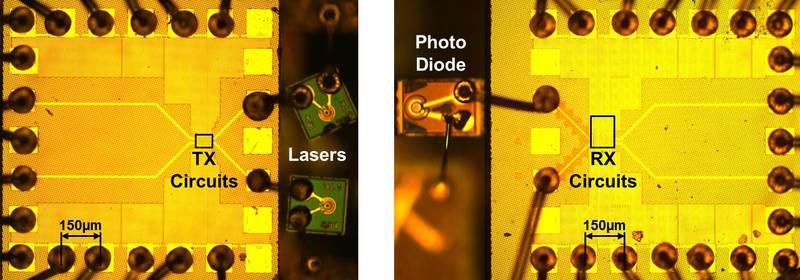Ultra-high-speed optical communications set a new energy efficiency record
The IBM research team at the United States Defense Advanced Research and Development Agency (DAPRA) program has found a way to transfer large amounts of data with unprecedentedly low energy consumption. They increased the speed of information transfer by 66%, reducing the energy consumed by almost two times, when compared with the previous record.
IBM researchers have developed an optical communication channel that provides a data transfer rate of 25 Gb / s using a total of 24 milliwatts of total capacity
(1 pico jole per bit).

The exaflops-level supercomputers operate at a speed of 10 18 floating point operations per second. Scientists suggest that such supercomputers will allow them to simulate climate across the planet, simulate a cell at the molecular level, design nanostructures, and more.
')
“We expect the exaflops-level computers to be created by 2020, but a lot of research is still needed to make this possible,” says Jonathan E. Proesel, a researcher at the IBM J. Watson Research Center. in Yorktown Heights, New York.
In order to achieve ultra-high computing speeds, researchers need a way to quickly transfer huge amounts of data, spending a minimum of energy.
Scientists managed to create a communication chip manufactured using 32 nm SOI CMOS (silicon-on-insulator complementary metal-oxide-semiconductor) technology, on which lasers shining from the surface of vertical cavities (vertical-cavity surface-emitting lasers, VCSELs) and Photo sensors made by Sumitomo Electric Device Innovations USA (formerly known as Emcore).
According to Proesel, scientists continue research aimed at increasing the speed of optical communications and reducing power consumption. Earlier, increasing the speed of information transfer, no one thought about the energy problem, but now, when the number of optical channels in one supercomputer will amount to thousands and hundreds of thousands, the energy problem can become very serious.
Via
IBM researchers have developed an optical communication channel that provides a data transfer rate of 25 Gb / s using a total of 24 milliwatts of total capacity
(1 pico jole per bit).

The exaflops-level supercomputers operate at a speed of 10 18 floating point operations per second. Scientists suggest that such supercomputers will allow them to simulate climate across the planet, simulate a cell at the molecular level, design nanostructures, and more.
')
“We expect the exaflops-level computers to be created by 2020, but a lot of research is still needed to make this possible,” says Jonathan E. Proesel, a researcher at the IBM J. Watson Research Center. in Yorktown Heights, New York.
In order to achieve ultra-high computing speeds, researchers need a way to quickly transfer huge amounts of data, spending a minimum of energy.
Scientists managed to create a communication chip manufactured using 32 nm SOI CMOS (silicon-on-insulator complementary metal-oxide-semiconductor) technology, on which lasers shining from the surface of vertical cavities (vertical-cavity surface-emitting lasers, VCSELs) and Photo sensors made by Sumitomo Electric Device Innovations USA (formerly known as Emcore).
According to Proesel, scientists continue research aimed at increasing the speed of optical communications and reducing power consumption. Earlier, increasing the speed of information transfer, no one thought about the energy problem, but now, when the number of optical channels in one supercomputer will amount to thousands and hundreds of thousands, the energy problem can become very serious.
Via
Source: https://habr.com/ru/post/174737/
All Articles